Development of Temperature Sensor Based on AlN/ScAlN SAW Resonators
Abstract
:1. Introduction
2. Device Design and Fabrication
2.1. Design and Fabrication of SAW Resonator

2.2. Design of SAW Oscillator

2.3. Design of Wireless Sensor System
3. Experiment and Result
3.1. Direct Measurement Method by Network Analyzer
3.2. Measurement by Oscillator Circuit
3.3. Measurement by Wireless Test System

4. Discussion and Conclusions
Author Contributions
Funding
Data Availability Statement
Acknowledgments
Conflicts of Interest
References
- Gulati, K.; Boddu, R.S.K.; Kapila, D.; Bangare, S.L.; Chandnani, N.; Saravanan, G. A review paper on wireless sensor network techniques in Internet of Things (IoT). Mater. Today Proc. 2022, 51, 161–165. [Google Scholar] [CrossRef]
- Wang, M.W.; Yao, Z.; Guo, W.Q.; Li, Q.H.; Li, Q.J. Design of the Chemical Reaction Tank Temperature Acquisition System Based on Wireless Sensor Networks. Adv. Mater. Res. 2014, 945–949, 1982–1986. [Google Scholar] [CrossRef]
- Tang, Z.; Wu, W.; Gao, J. A wireless passive SAW delay line temperature and pressure sensor for monitoring water distribution system. In 2018 IEEE SENSORS; IEEE: Piscataway, NJ, USA, 2018; pp. 1–4. [Google Scholar] [CrossRef]
- Fachberger, R.; Erlacher, A. Monitoring of the temperature inside a lining of a metallurgical vessel using a SAW temperature sensor. Procedia Chem. 2009, 1, 1239–1242. [Google Scholar] [CrossRef]
- Binder, A.; Fachberger, R. Wireless SAW temperature sensor system for high-speed high-voltage motors. IEEE Sens. J. 2010, 11, 966–970. [Google Scholar] [CrossRef]
- Thiele, J.A.; Da Cunha, M.P. High temperature LGS SAW gas sensor. Sens. Actuators B Chem. 2006, 113, 816–822. [Google Scholar] [CrossRef]
- Neumeister, J.; Thum, R.; Lüder, E. A SAW delay-line oscillator as a high-resolution temperature sensor. Sens. Actuators A Phys. 1990, 22, 670–672. [Google Scholar] [CrossRef]
- Penza, M.; Cassano, G. Relative humidity sensing by PVA-coated dual resonator SAW oscillator. Sens. Actuators B Chem. 2000, 68, 300–306. [Google Scholar] [CrossRef]
- Ai, Y.; Lv, H.; Huang, Y.; He, J.; Wang, Y.; Wu, J.; Zhang, Y. AlN/Sapphire-based SAW resonators with Q over 10,000 for temperature sensors. IEEE Sens. J. 2023, 23, 8261–8267. [Google Scholar] [CrossRef]
- Viens, M.; Cheeke, J.D.N. Highly sensitive temperature sensor using SAW resonator oscillator. Sens. Actuators A Phys. 1990, 24, 209–211. [Google Scholar] [CrossRef]
- Schimetta, G.; Dollinger, F.; Scholl, G.; Weigel, R. Wireless pressure and temperature measurement using a SAW hybrid sensor. In Proceedings of the 2000 IEEE Ultrasonics Symposium. Proceedings. An International Symposium (Cat. No. 00CH37121), San Juan, PR, USA, 22–25 October 2000; Volume 1, pp. 445–448. [Google Scholar] [CrossRef]
- Sorokin, A.; Shepeta, A.; Wattimena, M. Wireless SAW passive tag temperature measurement in the collision case. J. Phys. Conf. Ser. 2018, 1008, 012015. [Google Scholar] [CrossRef]
- Zhou, X.; Tan, Q.; Liang, X.; Lin, B.; Guo, T.; Gan, Y. Novel multilayer SAW temperature sensor for ultra-high temperature environments. Micromachines 2021, 12, 643. [Google Scholar] [CrossRef]
- Kang, A.; Zhang, C.; Ji, X.; Han, T.; Li, R.; Li, X. SAW-RFID enabled temperature sensor. Sens. Actuators A Phys. 2013, 201, 105–113. [Google Scholar] [CrossRef]
- Lin, B.; Liu, Y.; Cai, Y.; Zhou, J.; Zou, Y.; Zhang, Y.; Liu, W.; Sun, C. A high Q value ScAlN/AlN-based SAW resonator for load sensing. IEEE Trans. Electron Devices 2021, 68, 5192–5197. [Google Scholar] [CrossRef]
- Singh, H.; Parmar, Y.; Raj, V.B.; Pandya, H.M.; Kumar, J.; Mishra, M.; Nimal, A.T.; Sharma, M.U. Sensitivity enhancement studies of SAW vapor sensor by oscillator tuning using varactor diode. IEEE Sens. J. 2017, 17, 1391–1398. [Google Scholar] [CrossRef]
- Zhao, C.; Geng, W.; Qiao, X.; Xue, F.; He, J.; Xue, G.; Liu, Y.; Wei, H.; Bi, K.; Li, Y.; et al. Anti-irradiation SAW temperature sensor based on 128° YX LiNbO3 single crystal. Sens. Actuators A Phys. 2022, 333, 113230. [Google Scholar] [CrossRef]
- Zhang, Y.; Tan, Q.; Zhang, L.; Zhang, W.; Xiong, J. A novel SAW temperature-humidity-pressure (THP) sensor based on LiNbO3 for environment monitoring. J. Phys. D Appl. Phys. 2020, 53, 375401. [Google Scholar] [CrossRef]
- Hasan, S.A.; Gibson, D.; Song, S.; Wu, Q.; Ng, W.P.; McHale, G.; Dean, J.; Fu, Y.Q. ZnO thin film based flexible temperature sensor. In 2017 IEEE SENSORS; IEEE: Piscataway, NJ, USA, 2017; pp. 1–3. [Google Scholar] [CrossRef]
- Liu, Y.; Lin, B.; Xie, Y.; Soon, B.W.; Cai, Y.; He, J.; Sun, C. Boosting Performance of SAW Resonator via AlN/ScAlN Composite Films and Dual Reflectors. IEEE Trans. Ultrason. Ferroelectr. Freq. Control 2023. [Google Scholar] [CrossRef] [PubMed]
- Nian, L.; Qu, Y.; Gu, X.; Luo, T.; Xie, Y.; Wei, M.; Cai, Y.; Liu, Y.; Sun, C. Preparation, Characterization, and Application of AlN/ScAlN Composite Thin Films. Micromachines 2023, 14, 557. [Google Scholar] [CrossRef] [PubMed]
- Luo, T.; Xu, Q.; Wen, Z.; Qu, Y.; Zhou, J.; Lin, B.; Cai, Y.; Liu, Y.; Sun, C. Spurious-Free S1 Mode AlN/ScAlN-Based Lamb Wave Resonator with Trapezoidal Electrodes. IEEE Electron Device Lett. 2023, 44, 574–577. [Google Scholar] [CrossRef]
- Bjurström, J.; Katardjiev, I.; Yantchev, V. Lateral-field-excited thin-film Lamb wave resonator. Appl. Phys. Lett. 2005, 86, 154103. [Google Scholar] [CrossRef]
- Yantchev, V.; Enlund, J.; Biurström, J.; Katardjiev, I. Design of high frequency piezoelectric resonators utilizing laterally propagating fast modes in thin aluminum nitride (AlN) films. Ultrasonics 2006, 45, 208–212. [Google Scholar] [CrossRef] [PubMed]
- Liu, J.; Zhao, Z.; Zhang, M.; Jin, J.; Zhu, Y.; Fang, Z.; Gao, T.; Du, L. Analyzing the effect of the Front-end circuit for the FBAR sensor. Measurement 2020, 151, 107237. [Google Scholar] [CrossRef]
- Zou, Y.; Gao, C.; Zhou, J.; Liu, Y.; Xu, Q.; Qu, Y.; Liu, W.; Soon, J.B.W.; Cai, Y.; Sun, C. Aluminum scandium nitride thin-film bulk acoustic resonators for 5G wideband applications. Microsyst. Nanoeng. 2022, 8, 124. [Google Scholar] [CrossRef] [PubMed]
- Pohl, A. A review of wireless SAW sensors. IEEE Trans. Ultrason. Ferroelectr. Freq. Control 2000, 47, 317–332. [Google Scholar] [CrossRef]
- Wen, Y.; Li, P.; Yang, J.; Zheng, M. Detecting and evaluating the signals of wirelessly interrogational passive SAW resonator sensors. IEEE Sens. J. 2004, 4, 828–836. [Google Scholar] [CrossRef]
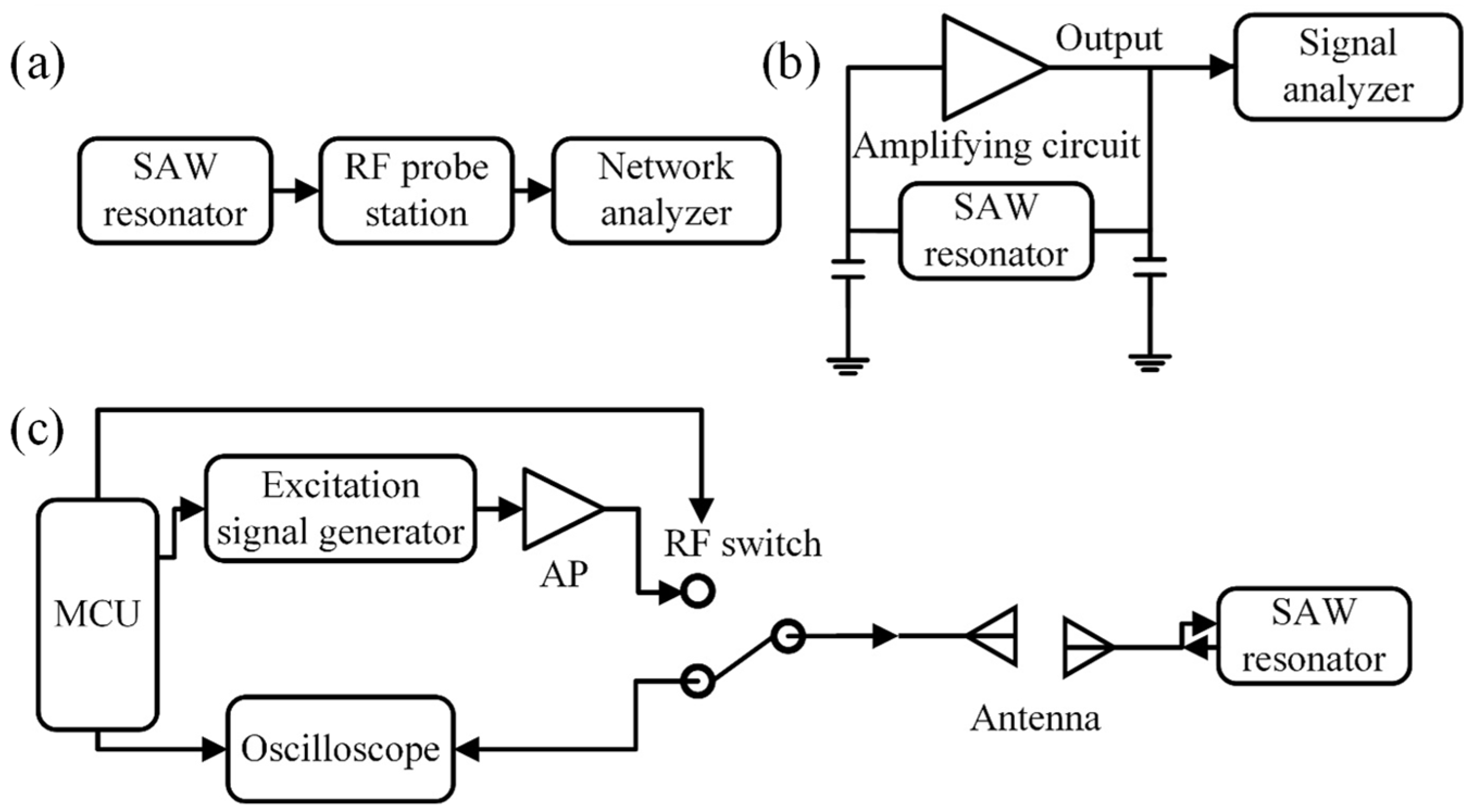

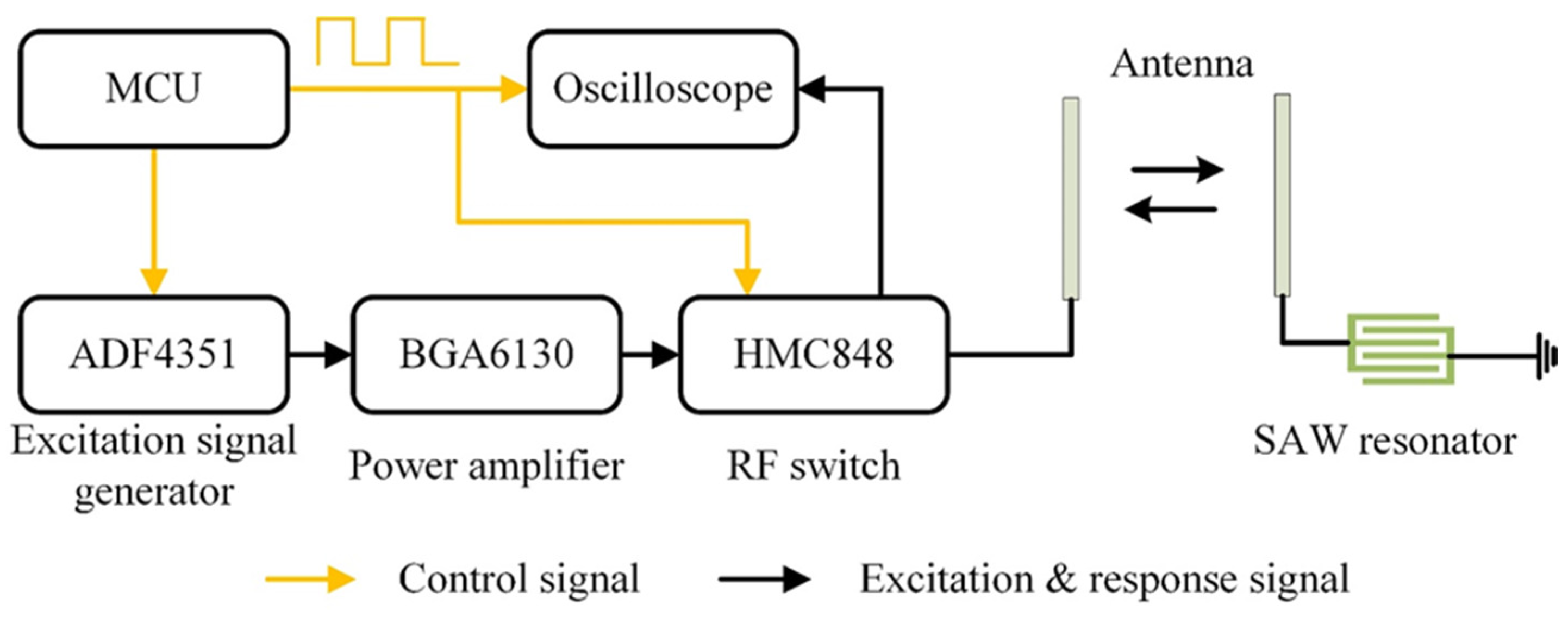


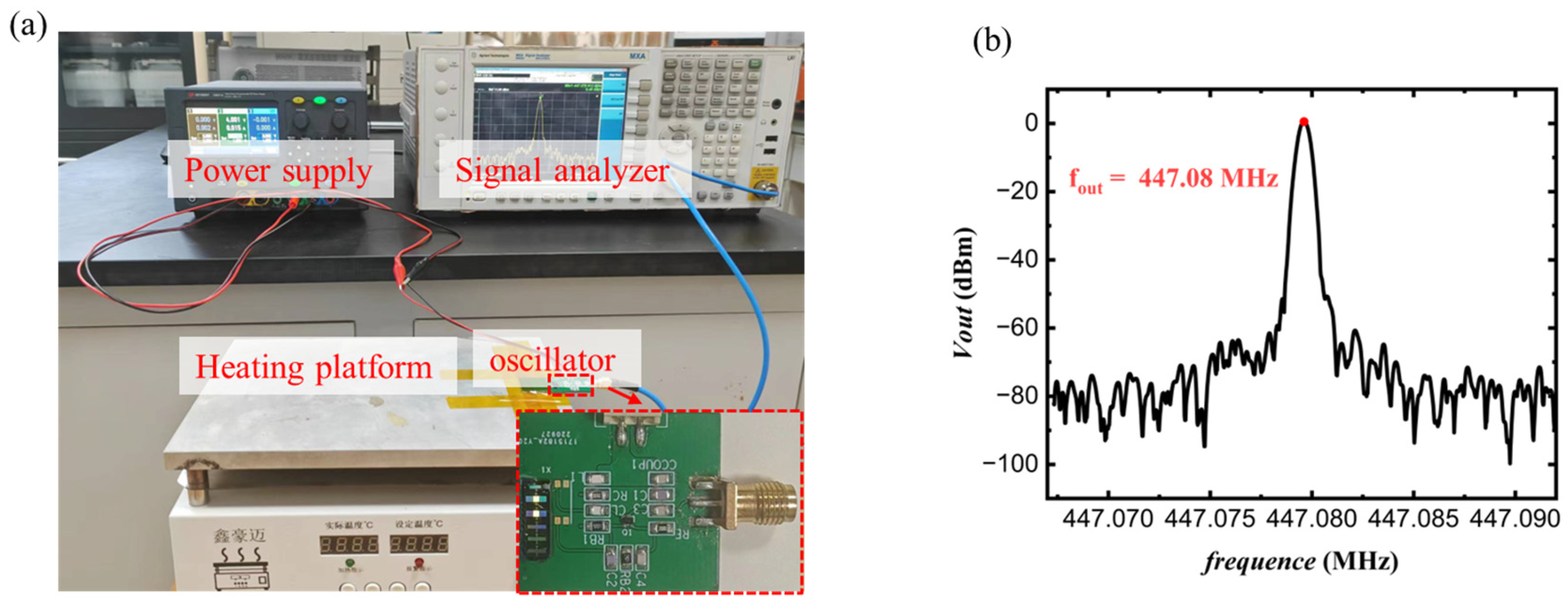
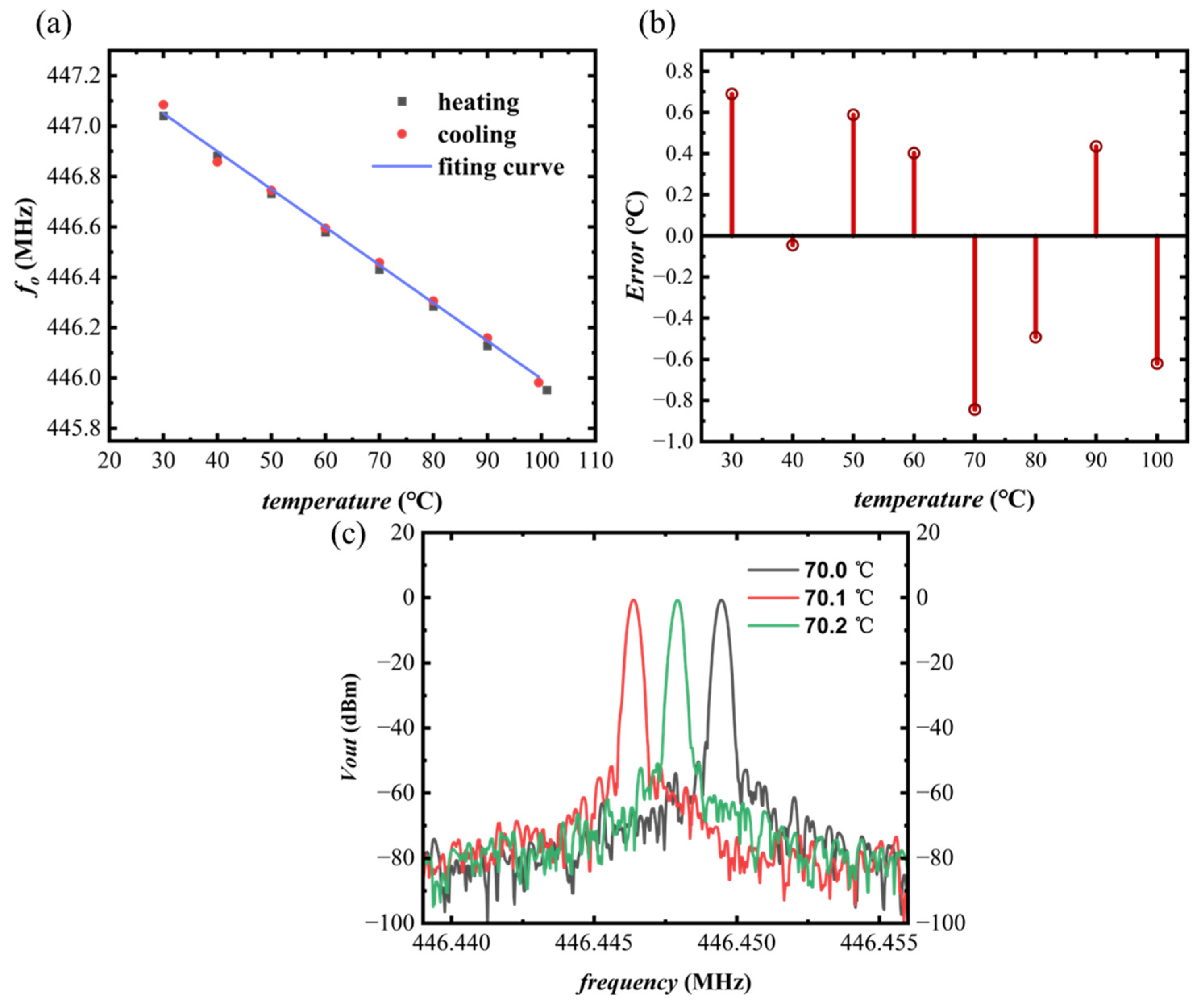
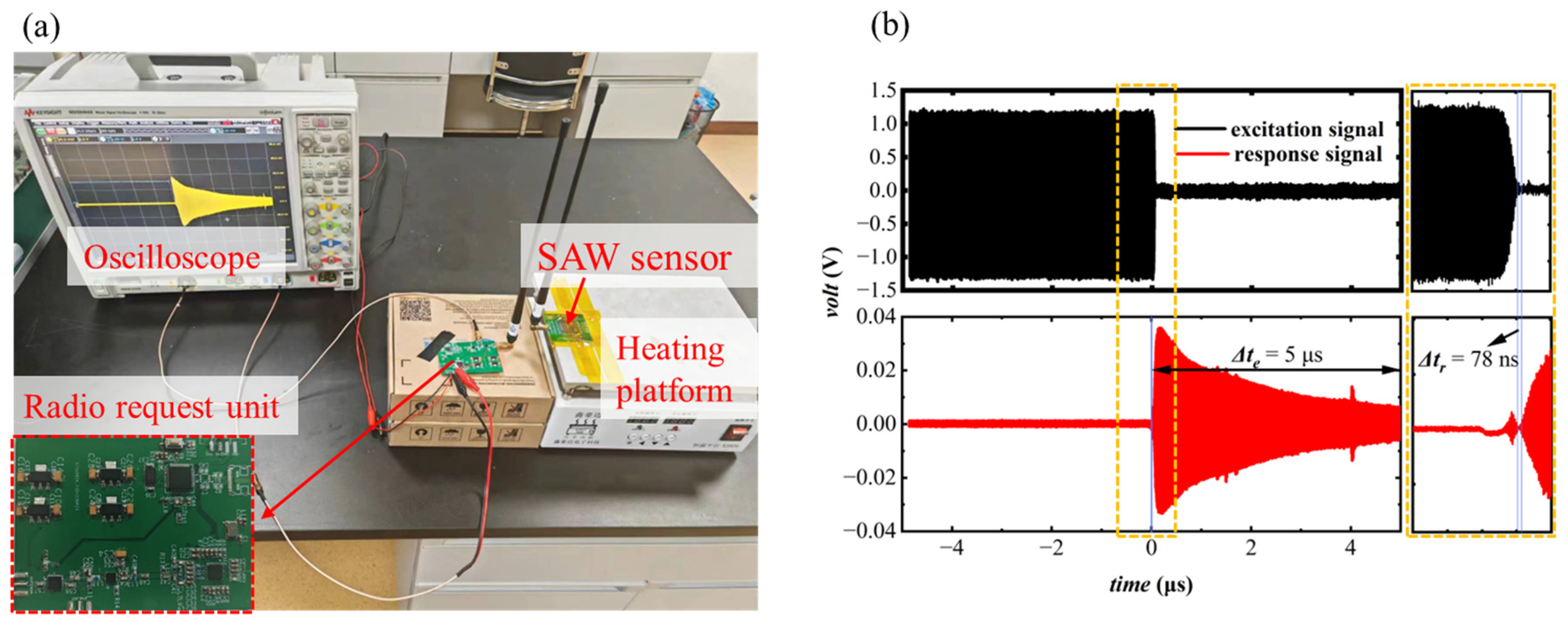
| Material | AlN | ScAlN |
|---|---|---|
| Target power (kW) | 6 | 10 |
| Pulsing frequency (kHz) | 100 | 100 |
| Temperature (°C) | 200 | 200 |
| Ar flow (sccm) | 25 | 19 |
| N2 flow (sccm) | 155 | 105 |
| Base pressure (Torr) | <5 × 10−8 | <2 × 10−7 |
| Cm | Lm | Rm | C0 | R0 | Rs |
|---|---|---|---|---|---|
| 10.007 fF | 12.697 nH | 2.000 Ohm | 3.544 pF | 12.602 Ohm | 15.724 Ohm |
Disclaimer/Publisher’s Note: The statements, opinions and data contained in all publications are solely those of the individual author(s) and contributor(s) and not of MDPI and/or the editor(s). MDPI and/or the editor(s) disclaim responsibility for any injury to people or property resulting from any ideas, methods, instructions or products referred to in the content. |
© 2023 by the authors. Licensee MDPI, Basel, Switzerland. This article is an open access article distributed under the terms and conditions of the Creative Commons Attribution (CC BY) license (https://creativecommons.org/licenses/by/4.0/).
Share and Cite
Wei, M.; Liu, Y.; Qu, Y.; Gu, X.; Wang, Y.; Liu, W.; Cai, Y.; Guo, S.; Sun, C. Development of Temperature Sensor Based on AlN/ScAlN SAW Resonators. Electronics 2023, 12, 3863. https://doi.org/10.3390/electronics12183863
Wei M, Liu Y, Qu Y, Gu X, Wang Y, Liu W, Cai Y, Guo S, Sun C. Development of Temperature Sensor Based on AlN/ScAlN SAW Resonators. Electronics. 2023; 12(18):3863. https://doi.org/10.3390/electronics12183863
Chicago/Turabian StyleWei, Min, Yan Liu, Yuanhang Qu, Xiyu Gu, Yilin Wang, Wenjuan Liu, Yao Cai, Shishang Guo, and Chengliang Sun. 2023. "Development of Temperature Sensor Based on AlN/ScAlN SAW Resonators" Electronics 12, no. 18: 3863. https://doi.org/10.3390/electronics12183863
APA StyleWei, M., Liu, Y., Qu, Y., Gu, X., Wang, Y., Liu, W., Cai, Y., Guo, S., & Sun, C. (2023). Development of Temperature Sensor Based on AlN/ScAlN SAW Resonators. Electronics, 12(18), 3863. https://doi.org/10.3390/electronics12183863








